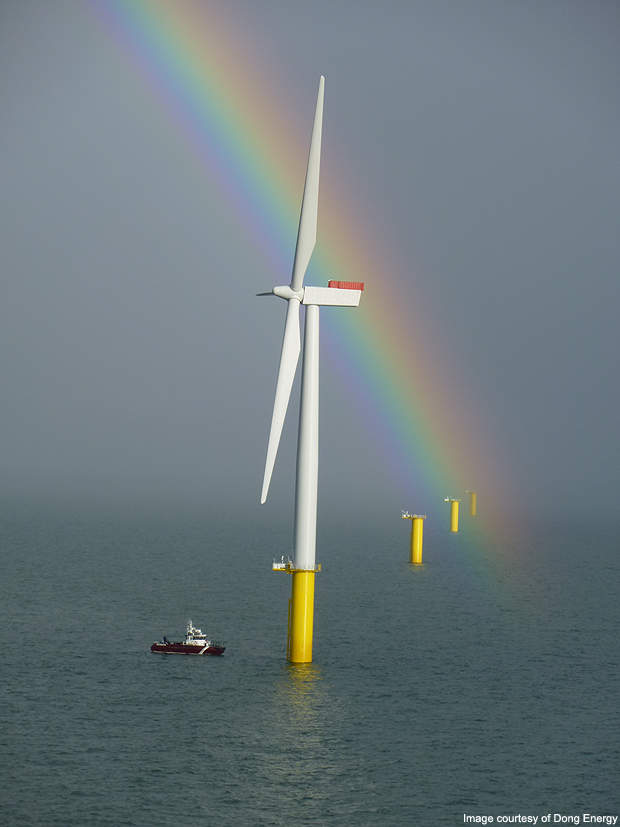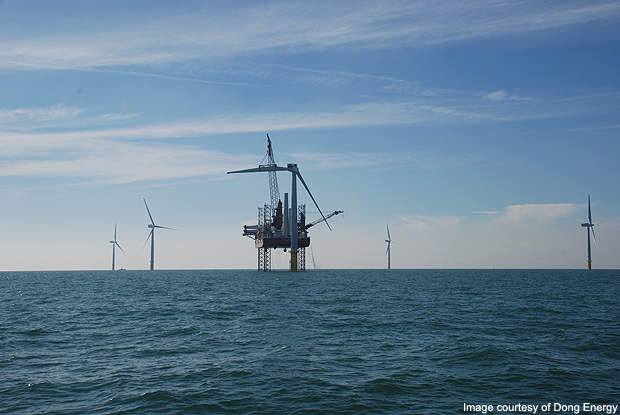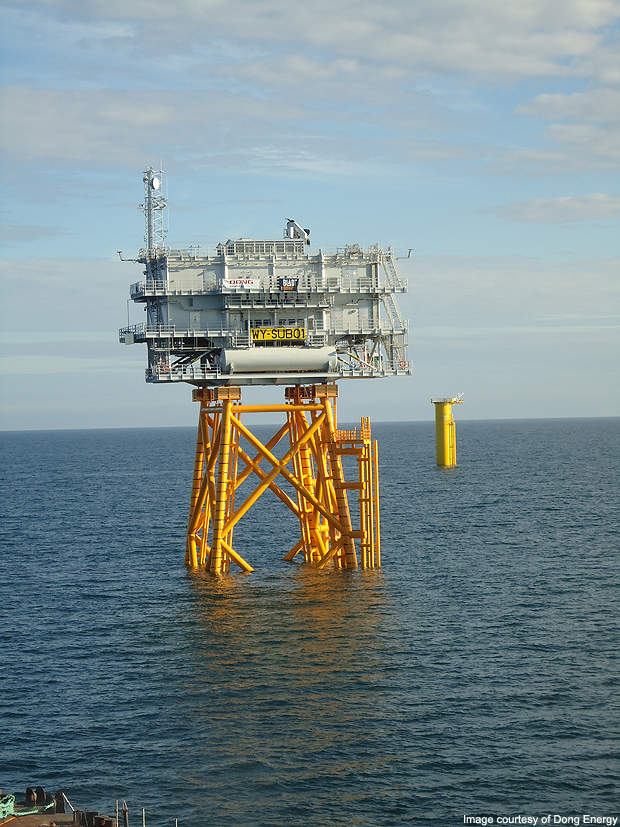Walney Offshore Wind Farm, located 15km west of Barrow-in-Furness in Cumbria, UK, began generating power from its first turbine in January 2011. The turbine is connected to the national grid through an offshore transformer at Heysham.
Walney is the world’s largest wind farm, claims its operator DONG Energy. The wind farm consists of 102 turbines which were installed in two phases, Walney I and Walney II. Built at a cost of £1bn ($1.58bn), the project delivers 367.2MW of combined energy sufficient to power more than 320,000 households in the UK.
Walney offshore wind farm development
Walney I became fully operational in May 2011. Electricity from the last turbine (51st) was exported to the grid on 30 May 2011. Power generated from Walney I can serve nearly 160,000 households.
The wind farm was formally inaugurated in February 2012 following the completion of Walney II, the second phase of the project. All 102 turbines of the project were operational by April 2012 and the wind farm was fully commissioned in June 2012.
The wind farm is owned by Dong Energy (50.1%), Scottish and Southern Energy (SSE-25.1%) and a consortium of PGGM and Dutch Ampère Equity Fund (24.8%).
Dong Energy is the leading partner of the wind farm. It has signed a 15-year long term power purchase agreement (PPA) with the consortium of PGGM and Dutch Ampère Equity Fund for the purchase of the consortium’s share of electricity from the project.
The company plans to sell power purchased from the consortium and the environmental benefits received from the British Government to the local market.
Details of the Cumbrian wind energy project
Walney is constructed along a north-west to south-east direction. It covers an area of approximately 73km².
Walney I and II each have 51 Siemens turbines with a rated capacity of 3.6MW. The turbines are 749m-958m apart and installed in rows.
Turbines installed at Walney I have a rotor diameter of 107m and are 137m tall, to the tip of the blade.
Walney II has turbines with a rotor diameter of 120m. The turbines have a maximum height of 150m to the tip of the blade.
Turbine arrays are connected by underwater sea cables to an offshore substation, where the voltage is stepped up from 34kV to 132kV before being exported to an onshore substation.
The Stanah onshore substation and export cable near Blackpool were hooked up to the national grid in August 2011. The offshore export cable and transformer also came online at the same time.
Project development by Dong Energy
The project was initially 100% owned by Dong Energy. In December 2009 SSE acquired a 25.1% share in the project, which was followed by a consortium of PGGM and Dutch Ampère Equity Fund, acquiring 24.8% in December 2010.
The consortium paid £16m ($25.3m) to acquire the share. It has also shared the project construction cost on a pro-rata basis. The purchase price, however, did not include payment for transmission assets which will be owned by a separate operator in future.
Blue Transmission acquired the transmission assets for Walney I for £105m ($166.4m), while the transmission assets for Walney II are still owned by DONG Energy’s subsidiary DONG Walney (UK).
Dong Energy has provided interim finance to the consortium for their share of the construction cost. PGGM / Dutch Ampère Equity Fund will provide external financing to Dong Energy.
Construction of turbines and substations for Walney I and Walney II
Construction of Walney I commenced in March 2010. The monopiles were laid by jack-up vessels Vagant and Goliath, operated by Belgium-based GeoSea.
The first monopile was installed in April 2010 and the export cable was shipped to the site at the same time. The monopiles are placed 30m deep into the seabed. Each monopile is 56m tall and weighs 550t. The Walney I offshore substation was placed within the wind farm area. It weighs 1,100t and was erected in June 2010.
Seajacks Kraken and Seajacks Leviathan owned by Seajacks UK were contracted for the turbine installations in Walney I and Walney II respectively. Sea Worker, a jack-up barge operated by A2Sea, was used to install the turbines.
The first turbine of Walney I was installed in July 2010 and the last one in May 2011. The turbines are now generating power for the national grid.
The first turbine of Walney II was installed in June 2011. Of the total 51 turbines, 49 were installed by September 2011. Installation of the last two machines and 23 array cables was delayed due to adverse weather conditions. Walney II came online by March 2012. Its turbines are placed 25m-30m deep, which required longer and heavier monopiles weighing up to 800t.
Power generated by Walney II is brought onshore in front of Thornton Gate through a 132kV underwater cable. The cargo ship Annette, owned by SAL, was contracted to deliver the monopiles to the site.
Stemat 82, a cable installation vessel, was used to install the array cables in the seabed. The cables were placed in the J-tube and protected with a layer of rocks to prevent scouring.
Walney wind farm contractors
Seabed Power was awarded the contract for transporting and installing more than 92km of 33kV array cables for Walney I. The cables were supplied by the nkt cables group.
Seabed Power was also responsible for laying 44km and 43km of 132kV export cables in two different routes. The cables were supplied by Prysmian Group in a €24.5m contract. Prysmian was also awarded a €18m contract to supply similar 132kV cables for Walney II.
The offshore substation steel structures and jackets were contracted to Bladt Industries in 2009. The first set for Walney I was delivered in May 2010. The aluminium hydraulic cylinders were manufactured by Holmatro. Powerstream Electrical Services built the onshore substation at Heysham in a contract worth $1.1m in June 2010.
Other major contractors of Walney I were EEW-Special Pipes Construction (SPC) Rostock for the manufacture of 51 monopiles, Visser & Smit Marine Contracting (VSMC) for the Stemat 82 cable lay vessel, Tekmar Solutions for a cable protection system, Proserv Offshore for cleaning of the marine growth around the pile and Ledsham for the construction of an 11kV substation for Siemens.
Walney II contractors included A2Sea and Ballast Nedam for installation of the foundations, Norway-based Draka Norsk Kabel (DNK) for installing the inter-array cables and associated logistics and Offshore Marine Management (OMM) for termination and testing of inter-array cables.
Dong Energy signed an agreement with Associated British Ports (ABP) to use 18 acres of the Barrow area for handling essential components of the wind turbines during construction. Audit of the barge and tugs used in the project was carried by Specialist Marine Consultants.
NIRAS was contracted for a number of consultation works related to the project, including geophysical surveys, management of installations, logistics planning and so on. Semco Maritime was involved in the cable laying works.
SeaRoc’s web application provided GIS data during the construction. Found Ocean was contracted to provide offshore grouting for the substation of Walney II. VolkerInfra installed the cable duct of the array cables.
Future for UK’s Walney offshore wind farm
Dong Energy plans to extend the Walney offshore wind farm by a further 750MW. The company signed a lease agreement with the Crown Estate in May 2010. The proposal is expected to be submitted for planning consent in 2013 and the construction is anticipated to begin in 2014, subject to approval of the proposal by the government.
The extension is expected to cover an area of 145 square kilometres. It will include one offshore substation, 33kV array cables, three core underwater offshore cables and an onshore connection point at a substation at either Heysham, Stanah or Penwortham.
ABPmer was appointed to conduct the environmental impact assessment for the extension.
Related content
Burbo Offshore Wind Farm, United Kingdom
Twenty five 3.6MW wind turbines have been installed at the 90MW Burbo Offshore Wind Farm in Liverpool Bay, Wales.
Blyth Wind Turbine Blade Test Facility, Northumberland, United Kingdom
The Blyth offshore wind turbine blade test facility is located in Northumberland, in the UK.
Crystal Rig Wind Farm Expansion, Scotland
The addition of 60 turbines to the existing 62.5MW Crystal Rig wind farm in East Lothian, Scotland.







